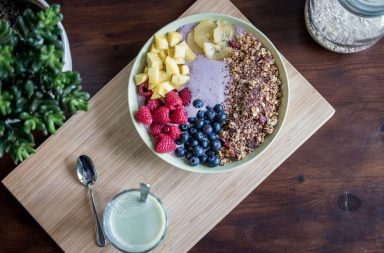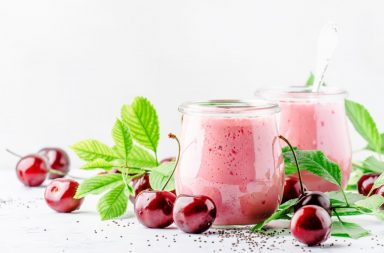Salmon is a popular and tasty fish known for its many health benefits and versatile use in cooking. If you’re choosing to eat salmon, then you’re already making a healthy choice for your body! But what is the healthiest way to cook a salmon fillet?
We all know the general benefits of eating fish as part of a healthy diet. The main one being it’s high in Omega 3 – a vital nutrient for a healthy heart. Not only that, but salmon can be enjoyed as part of a weight-loss diet, alongside night-time smoothies and regular exercise.
Best Night-time Smoothie for Weight Loss Recipe
Salmon is used in many different recipes and can be cooked in many different ways. But what is the healthiest way to enjoy this popular fish?
Well, we’re going to tell you the healthiest way to cook a salmon fillet! Plus, we’re going to give you all the health benefits of this popular fish!
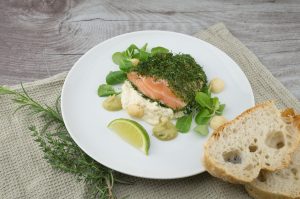
Photo credit: Free-Photos via Pixabay
What Are the Health Benefits of Eating Salmon?
All fish tends to fall under two categories: fatty or lean. Both of these types of fish are incredibly important to our health; however, it is thought that fatty fish provides the most nutrients.
Salmon fillet falls under fatty fish, but don’t let the word ‘fatty’ fool you into thinking it’s unhealthy! In actual fact, the fats found in salmon are what make it such an important part of our diets!
So, what exactly are the health benefits of eating salmon fillet? Let’s take a closer look!
Can Lower Blood Pressure
Salmon fillet is rich in Omega 3 and fatty acids, more so than most other types of fish. Omega 3 helps to lower blood pressure and can also help us get rid of high cholesterol! Both of these things combined can significantly reduce the chance of developing serious conditions such as heart disease. We’d say that’s a rather good benefit to eating salmon fillet!
Helps Aid Weight Loss

Photo by Bill Oxford on Unsplash
Yes, if want to lose weight, but still enjoy a tasty dinner, a salmon fillet is the perfect solution! One of the health benefits of this fatty fish is that it can always be enjoyed, even if you’re on a diet. This is because salmon is packed full of lean proteins and is low in saturated fats – ideal for nutritious meals.
Of course, you need to make sure you are using a healthy cooking method. All of which we’ll tell you later on in this article!
Has Anti-inflammatory Properties
Ok, so we know other health products such as Manuka honey has anti-inflammatories listed in its benefits – but did you know salmon does too? In actual fact, salmon is full of anti-inflammatory properties, all found in Omega-3. This is beneficial to all of us in reducing weight gain and preventing chronic diseases.
Manuka Honey Benefits and Side Effects: What Are They?
Can Promote Healthy Skin
A benefit we can all be thankful to salmon for – it can give you healthy, glowing skin! Yes, really! Again, the fatty acids (aren’t they the best) found in the salmon fillet, increase the amount of water your skin holds. This leads to healthier, brighter skin – particularly beneficial if you suffer from dry skin!
Good Food for Your Brain
Salmon is an excellent food for a sharp memory and focused brain. The high amount of Omega 3 found in this fish can improve cognitive function and even improve concentration! So, if you’ve got an exam coming up – try having salmon fillet for dinner!
As you can see, there are many health benefits to enjoying this fatty fish. All we need to know now is the healthiest way to cook salmon fillet!
Healthiest Way to Cook Salmon Fillet: Oven, Pan and BBQ
If you’re going to eat a healthy food such as salmon, you’ll want to know the best way to cook it so that it retains all of its wonderful nutrients.
Luckily, there are three healthy ways to cook salmon fillet, all of which leave you with tender, moist meat.
So, let’s find out the healthiest way to cook salmon fillet!
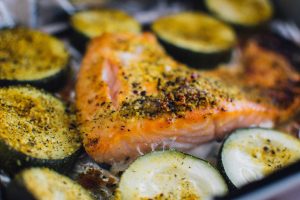
Photo credit: StockSnap via Pixabay
Cook Salmon Fillet Using Oven
Baking salmon fillet in the oven is a popular way to cook this fish. It is also extremely healthy, so long as you steer clear of using fatty glazes such as butter.
The healthiest way to bake salmon fillet in the oven is:
- Wrap each fillet in an individual foil parcel.
- Drizzle olive oil (optional) and sprinkle with fresh herbs, salt and pepper and a squeeze of lemon juice.
- Put the parcels on a baking tray and into the oven at 200 degrees Celsius.
- Leave to cook for roughly 10 – 15 minutes, or until the flesh becomes flaky.
Serve with boiled potatoes and asparagus for a healthy, delicious dinner!
Cook Salmon Fillet in a Pan
Another healthy way to cook salmon fillet is poaching it in a saucepan. Poaching adds little to no extra calories to this nutritious fish, making it a great option if you’re on a diet.
To poach salmon fillet in a pan:
- Place the salmon fillet in a large but shallow saucepan.
- Add enough liquid to just about cover the fillet. Water is the healthiest option; however, you can also use court-bouillon – an aromatic broth made with spices, herbs and vegetables.
- Cook the fish at the simmering point until it is cooked through. This will usually take around 10 minutes, depending on the size of the fillets.
You can serve this healthy poached salmon fillet with a side of couscous or rice for a light evening meal!
Salmon Fillet Cooked on the BBQ or Grill
With summer here, what better way to enjoy a healthy salmon fillet cooked on the BBQ! Say goodbye to stodgy burgers and hello to a light, healthy fish.
To cook salmon on the BBQ or grill, you are best using a fillet with the skin left on to prevent the flesh flaking apart.
- Wait until the BBQ or grill is medium hot.
- Place your salmon skin side down, onto a piece of foil.
- Season the salmon fillet with salt, pepper and a squeeze of lemon juice (optional). You can add any other fresh herbs you like too.
- Wrap the salmon in the foil so it is completely covered.
- Place on the BBQ or grill and cook for roughly 6 – 8 minutes.
- Flip the salmon fillet using a spatula and leave again for 6 – 8 minutes.
- Once the skin starts to flake easily, the fillet should be cooked through.
You can serve BBQ salmon fillet with a delicious salad and low-fat coleslaw for a healthy BBQ dish!
There you have the healthiest ways to cook a salmon fillet. Three healthy options to enjoy this fatty, nutrient-packed fish!
So, how often should we be eating salmon to keep our hearts, brains, and skin so healthy? And is there a healthier fish than salmon?
Read on to find out!
Salmon Health Benefits: How Often Should We Eat It?
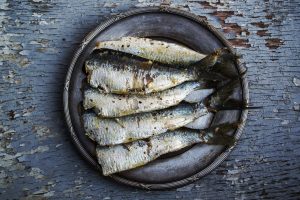
Photo credit: DanaTentis via Pixabay
We know that salmon fillet is an important source of Omega 3, the key to happy, healthy, hearts and brains. In actual fact, salmon is thought to be the healthiest fish you can eat.
But how often should we be eating this nutritious fish to make sure we are getting enough of the health benefits?
Well, the recommendation for a fatty fish such as salmon fillet is to try and eat one portion a week. This should be frequently enough to ensure a grown adult is getting enough Omega 3 as part of a healthy, varied diet.
Of course, just because salmon is the most nutrient-rich fish, it doesn’t mean there aren’t other fish you can enjoy in your diet! For example, mackerel is another healthy fish and is extremely high in protein. Mackerel is a great fish to enjoy post-workout to ensure your muscles can rest and repair!
In addition to mackerel, sardines are another nutrient-rich fish. In fact, they are one of the few food sources high in vitamin D and come at a lower cost than most other fish! Sardines make a great option for brunch when served with spinach and scrambled egg!
If you’re on a health kick and plan on enjoying salmon as part of a healthy weight loss diet, remember that exercise is also key! Anaerobic workouts are great for weight loss and can easily be done at home!
Try Out the Best Anaerobic Home Workouts!
